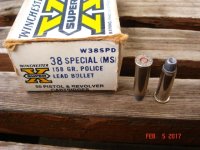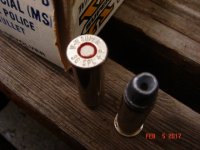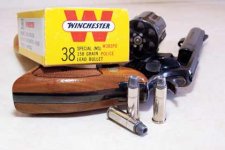You are using an out of date browser. It may not display this or other websites correctly.
You should upgrade or use an alternative browser.
You should upgrade or use an alternative browser.
Magnum loads from Colt Official Police
- Thread starter HighValleyRanch
- Start date
The comment about BB not caring about SAAMI specs deserves rebuttal.
They do the R&D for those who can't be bothered to do their own.
They have the lab that you don't want to buy yourself.
They are VERY cognizant of pressures.
They are very much concerned about safety among those who buy their products (both from a "We don't want to hurt anybody" viewpoint, and a "We don't want to get sued" angle).
Their stuff is consistently excellent quality.
Their stuff is expensive BECAUSE they did the R&D and they expand the envelope in bullet & load choices you generally won't find elsewhere.
They make no pretense of going after the mass market.
They produce products for those who want more performance in certain areas than the major makers will provide, for those who don't want to get into building their own, and for those who may only buy a box or two to last through several years.
As far as pressures go, they can run high.
The company does watch those in load development & does not sell bombs.
It sells high-performance ammunition.
The consumer has the responsibility of determining whether a high-performance load is appropriate in their particular gun or not.
Last September I ran some BB 158 LSWC gas-checked +P loads through a Smith 10 and a Colt OP, along with three other factory loads.
I did not chronograph through either gun.
Both guns were in excellent condition, the Colt was unfired from the early 60s & the Smith was lightly used from the 70s.
The BB produced a best-group at 25 yards through the Smith of five holes at 1 5/16 inch.
The BB wasn't the best performer among the four factory loads in the Colt, but did its tightest group at 2 3/8 inches.
The BB stood both guns up in my hands, literally.
Hot stuff.
Far more noticeable recoil than the next stiff load, a Black Hills 125 JHP +P.
If I were to carry a full-sized .38 again for defensive use, I'd go with a BB load without hesitation.
I'd do my own handloads at the upper levels of the manuals' charge ranges to come closer to the BB in recoil for realistic practice, but I'd actually carry the BB.
The only real factor I'd have any concerns about would be the broad axim that hotter loads GENERALLY run the risk of accelerated wear in a DA revolver, and for that reason alone I would not consider an older Colt V-Spring gun to be a viable candidate for such applications.
The basic action of an OP can stand up to hotter .38s, the 357 V-Springs did well with hotter magnums when those were introduced.
Both have the same internal vulnerability in the hand, though, and Colt can't service those anymore.
If I were going to shoot the OP here much, it'd be more mild ammo to prolong the life of the hand, and it'd be only occasionally, same reason.
And- SAAMI is not the final word on pressures, anyway.
Denis
They do the R&D for those who can't be bothered to do their own.
They have the lab that you don't want to buy yourself.
They are VERY cognizant of pressures.
They are very much concerned about safety among those who buy their products (both from a "We don't want to hurt anybody" viewpoint, and a "We don't want to get sued" angle).
Their stuff is consistently excellent quality.
Their stuff is expensive BECAUSE they did the R&D and they expand the envelope in bullet & load choices you generally won't find elsewhere.
They make no pretense of going after the mass market.
They produce products for those who want more performance in certain areas than the major makers will provide, for those who don't want to get into building their own, and for those who may only buy a box or two to last through several years.
As far as pressures go, they can run high.
The company does watch those in load development & does not sell bombs.
It sells high-performance ammunition.
The consumer has the responsibility of determining whether a high-performance load is appropriate in their particular gun or not.
Last September I ran some BB 158 LSWC gas-checked +P loads through a Smith 10 and a Colt OP, along with three other factory loads.
I did not chronograph through either gun.
Both guns were in excellent condition, the Colt was unfired from the early 60s & the Smith was lightly used from the 70s.
The BB produced a best-group at 25 yards through the Smith of five holes at 1 5/16 inch.
The BB wasn't the best performer among the four factory loads in the Colt, but did its tightest group at 2 3/8 inches.
The BB stood both guns up in my hands, literally.
Hot stuff.
Far more noticeable recoil than the next stiff load, a Black Hills 125 JHP +P.
If I were to carry a full-sized .38 again for defensive use, I'd go with a BB load without hesitation.
I'd do my own handloads at the upper levels of the manuals' charge ranges to come closer to the BB in recoil for realistic practice, but I'd actually carry the BB.
The only real factor I'd have any concerns about would be the broad axim that hotter loads GENERALLY run the risk of accelerated wear in a DA revolver, and for that reason alone I would not consider an older Colt V-Spring gun to be a viable candidate for such applications.
The basic action of an OP can stand up to hotter .38s, the 357 V-Springs did well with hotter magnums when those were introduced.
Both have the same internal vulnerability in the hand, though, and Colt can't service those anymore.
If I were going to shoot the OP here much, it'd be more mild ammo to prolong the life of the hand, and it'd be only occasionally, same reason.
And- SAAMI is not the final word on pressures, anyway.
Denis
HighValleyRanch
New member
Thanks DPris for that input. I have also found their ammo to be high quality and what they repute it to be. In another thread, I stated I shot their .38 +P outdoorsman and some mid range Amcor .357 through my security six and found the recoil impulse identical.
I found this from the Smith and Wesson forums discussing the .38-44 (added the bold type to emphasize the statement):
And then I found this in the safe from my brother's old ammo collection from when he was an Oakland police officer. It's an old box of Winchester Super X from the 1970's. Now I see that Winchester still makes the Winchester Super X, but lists it a around only 875 fps. So wondering if they downgraded their ammo but kept the same name. I have not choreographed this old ammo, but it would be interesting to see how fast it is.
So do you think that the current Winchester super X is the same as this stuff?
Interesting to note that the box is NOT MARKED +P, but the cases are?

I found this from the Smith and Wesson forums discussing the .38-44 (added the bold type to emphasize the statement):
Addition - I consulted the 1943 Western ammunition handbook. The ballistics information provided is mostly identical to that from Winchester given above. However, it is made clear that the Western .38 Special Super-X load is the same as the .38-44. There are no longer listings for the 158 grain lead and 158 grain metal point bullets for the .38 Special Super-X, only for the 150 grain metal point and 150 grain metal piercing bullets, both at 1175 ft/sec from a 5" barrel.
I'd bet that virtually identical ballistic information would be found in Remington publications of that time period, except that Remington's equivalent to Winchester's Super Speed and Western's Super-X is called "Hi-Speed."
And then I found this in the safe from my brother's old ammo collection from when he was an Oakland police officer. It's an old box of Winchester Super X from the 1970's. Now I see that Winchester still makes the Winchester Super X, but lists it a around only 875 fps. So wondering if they downgraded their ammo but kept the same name. I have not choreographed this old ammo, but it would be interesting to see how fast it is.
So do you think that the current Winchester super X is the same as this stuff?
Interesting to note that the box is NOT MARKED +P, but the cases are?
Attachments
I won't re-open the debate over down-loaded .38 Specials in current factory loads as compared to older standards.
I'll just say one of the 158-grain lead handloads leftover from my wife's CAS days (a VERY mild CAS-level powder charge) chronoed hotter than a current 158 factory load a year or two ago in some comps I was doing.
Thirty years back, when S&W was marketing .38 Special ammo under their own brand, they had a load hot enough to qualify for the deer hunt in my state.
Before my buddy at the PD acquired his 686, he'd carry the department's Model 64 as a backup in the Fall, with that S&W .38 Special load in it.
Denis
I'll just say one of the 158-grain lead handloads leftover from my wife's CAS days (a VERY mild CAS-level powder charge) chronoed hotter than a current 158 factory load a year or two ago in some comps I was doing.
Thirty years back, when S&W was marketing .38 Special ammo under their own brand, they had a load hot enough to qualify for the deer hunt in my state.
Before my buddy at the PD acquired his 686, he'd carry the department's Model 64 as a backup in the Fall, with that S&W .38 Special load in it.
Denis
HighValleyRanch
New member
Interesting to note that the box is NOT MARKED +P, but the cases are?
My best guess is that those cases do not match that box. They might be factory, or they might be loads put up in factory primed brass, but they are NOT the ammo that came in that box from the factory.
The cases say WW Super, NOT Super-X. Winchester used WW Super, Super-X and Super Speed, and WW (and possibly some I can't think of right now) as headstamps for different loads at different times.
one thing I've found is that verified factory boxes of ammo always have matching headstamps and box labels.
I'm a reloading rat, and have LOTS of reloaded ammo in various factory boxes, and very seldom are the rounds the ones that came in that box to start with. I think its quite possible that Super X box was simply re-used to hold different ammo.
Hmmm, looking at the BuffaloBore site, they quote 1255 fps from a six inch barrel and so their .38 +P Outdoorsman 158 grain Keith HC yields a whopping 530 foot pounds ME! That's in the mid range .357 magnum range, isn't it?
Now I've read that the Colt Official police was built to take the old 38/44 loads, maybe not as robust as the SW heavy frame versions, but still, my old Colt OP with its 6" barrel might work as a woods gun with those loads
Unless your sources worked at Colt and you can find period advertising warranting the pistol for 38/44 loads I would not give them much credence.
Your pistol is a beautiful example of a pre WW2 revolver. Just imagine stretching the frame, enlarging the cylinder, sort of worst case, or simply shooting the thing so the timing goes. You beat up that cylinder hand you are going to need a gunsmith to re time the mechanism. Which leads to the next question, you got parts and do you know a gunsmith who will work on those revolvers? Colt gunsmiths have gotten few and are not cheap, the last I checked. And parts, well, Colt does not carry parts for those old revolvers, nor will they work on them. Do you happen to have your own cache? If you don't, don't assume that parts will be easy to find.
I would shoot your old Colt Official Police with standard 38 Special loads only.
That is what I am doing with my D frame Colts. I have no desire to damage these out of production revolvers.
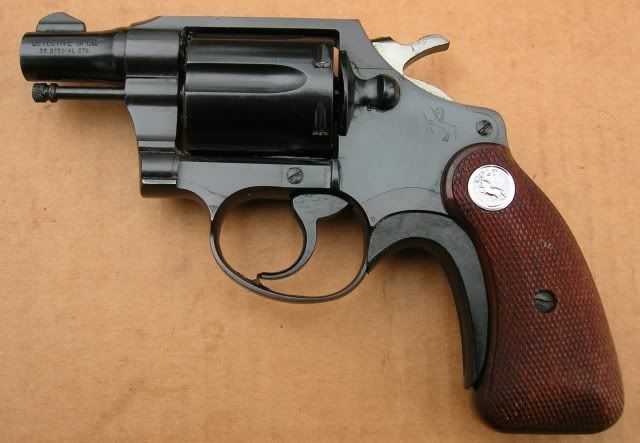
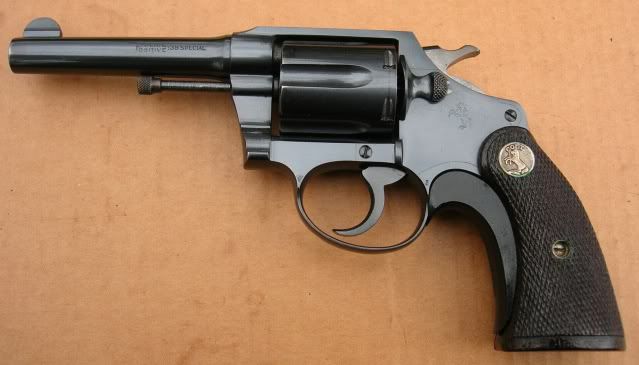
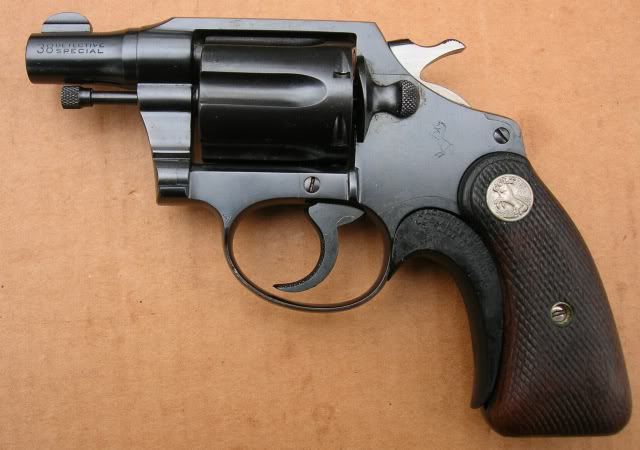
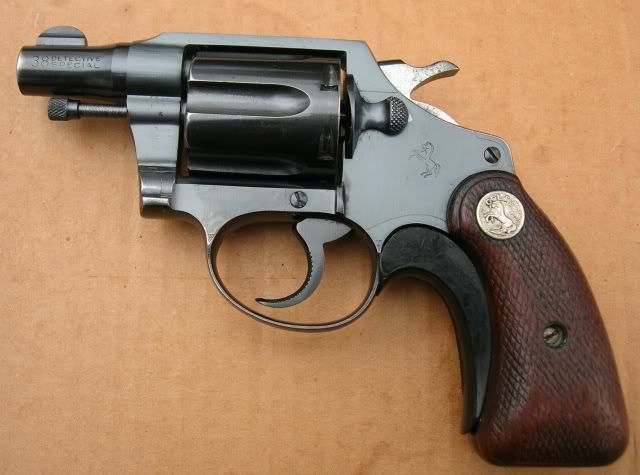
Pathfinder45
New member
In the ammo pictures, those are hollow-points, and the box says nothing about hollow-points. I have to agree; that ammo is not correct for the box. It happens a whole lot with old boxes of ammo from the gunshows. Not the original ammo that was in that box.
Jim Watson
New member
Unless your sources worked at Colt and you can find period advertising warranting the pistol for 38/44 loads I would not give them much credence.
Do not get me wrong, I do not recommend the practice now.
The guns are discontinued, the workers retired or deceased, the parts used up, and if you beat up a Colt, it is difficult to get it fixed.
But I used to have the Haven and Belden book with Colt catalog cuts up through 1940 and I still have a 1939 Stoeger's reprint.
So I do indeed have period advertising showing all Colt .38 Specials, including your Detective Special, as suitable for ".38 Short Colt, .38 Long Colt, .38 Colt Special, .38 S&W Special (full and mid-range loads) .38 Colt Special High Speed, .38 S&W Special High Speed, and .38-44 S&W Special cartridges."
HighValleyRanch
New member
My feeling is that they are the original rounds for the box, but they marked things differently back then. Not sure what MS stands for, but they are marked Police and maybe it was understood that meant the FBI load.
The box is clearly marked W38SPD as in the following:
I found this in another Firing Line thread on the .38 special FBI load:
And another from another thread on the FBI .38 special load from SW forums:
And then here is a link to an very interesting article about the FBI load:
http://www.shootingtimes.com/ammo/ammunition_st_crimelabtests_200807/
In the article:

The box is clearly marked W38SPD as in the following:
I found this in another Firing Line thread on the .38 special FBI load:
Hello CoolHandLu
No, There was an actual law Enforcment Load developed by Winchester back in the early 1960's. They came in the Older Yellow & Red box's and had a slightly hotter load rating for the .38 Special of 1060 FT/Sec and a Muzzle Energy of 395 Ft. Lbs. The bullet used was a Semi Wad Cutter 158 Grain MS Police lead Bullet. The end flap of the box's were clearly Marked .38 Special W38SPD 158 Grain Police lead Bullet. I hope this Helps, Hammer it
And another from another thread on the FBI .38 special load from SW forums:
When originally produced in the early 70s, the W-W LSWCHP had a claimed velocity of, I believe, 1090 fps. The Law Enforcement Handgun Digest of 1972 has a velocity chart on p. 188, which shows 1014 fps for this load (W38SPD) from a 4" revolver barrel. This has been 'watered down' to the current 890 fps as the other posters have pointed out. When old and present loadings are fired consecutively, there is a noticeable difference. Hope this helps. VL
And then here is a link to an very interesting article about the FBI load:
http://www.shootingtimes.com/ammo/ammunition_st_crimelabtests_200807/
In the article:
After months of crime-lab testing, the Dallas Police Department adopted a hollowpoint service load. The box lacks the +P designator because that standard did not exist in 1973.
Attachments
Last edited:
"But I used to have the Haven and Belden book with Colt catalog cuts up through 1940 and I still have a 1939 Stoeger's reprint.
So I do indeed have period advertising showing all Colt .38 Specials, including your Detective Special, as suitable for ".38 Short Colt, .38 Long Colt, .38 Colt Special, .38 S&W Special (full and mid-range loads) .38 Colt Special High Speed, .38 S&W Special High Speed, and .38-44 S&W Special cartridges.
You jogged my memory, I remember an article I read in the American Rifleman, sometimes in the 1970's or 80's. If memory is right, the article stated that Colt 38 Special revolvers could fire +P 38 Special ammunition, just that the owners could expect the revolvers to go out of time in something like 3000 to 6000 rounds.
Maybe the cylinder, frame and barrel are structurally able to handle +P, but where do you find a gunsmith who knows how to work on these things and where do you get the parts?
In my opinion, the best practice is to stick to standard loads.
I shot Skeeter loads thru my 1956 OP. Probably closers to 30,000+ than 20,000 cup. My observation was that it friggin hurts. Another observation was the faster you shot the 358429 and the 358156 the better the accuracy, especially Keith's design. I put 100 or so rounds of these loads thru the shooter due to the first observation. I never could get decent accuracy with 38 pressure loads using cast bullets so sold it. Those look like Army Special grips on your OP, do you know if they were original with gun?
HighValleyRanch
New member
Those look like Army Special grips on your OP, do you know if they were original with gun?
No, they were not the original, which are the wood checkered ones. I just liked those more. They are reproductions.
If memory is right, the article stated that Colt 38 Special revolvers could fire +P 38 Special ammunition, just that the owners could expect the revolvers to go out of time in something like 3000 to 6000 rounds
I don't know if your memory is right, or not, but that certainly sounds like something they would have said back then.
I have a Colt Agent, one of the later guns with the ejector rod shroud and a nice blue finish. I do know what Colt said about it when they sold it. They said the pistol would stand .38+P ammo, but they did not recommend it. AND, they said that if you shot +p, the pistol should be returned to the factory for inspection after 1,000 rounds.
The factory that would inspect and repair Colt revolvers no longer exists, and hasn't for some time now, so I'd be more than a bit cautious about shooting anything above standard in any Colt revolver these days.
Pathfinder45
New member
Salvadore, those cast bullets were simply too hard for low pressure loads. If they were made from a softer alloy, with a higher lead content, they would have worked better for you with lighter pressure loads.
Back in 1973 there were no manufacturers that made +P 38 special. But most ammo back then was actually hotter than today's so called +P. Buffalo Bore ammo is at or near the top as being the hottest for 38 special. One would have to reload to beat BB. I have fired limited amounts of BB ammo in some of my M&P 38 special S&W revolvers. Never had a problem. The Colt Official Police is stronger than the S&W M&P. If your revolver is in good condition I don't see a problem once in awhile. If a person were to shoot a large amount if might accelerate wear on the revolver but I don't see the revolver blowing up.
This is my take,
Howard
This is my take,
Howard

